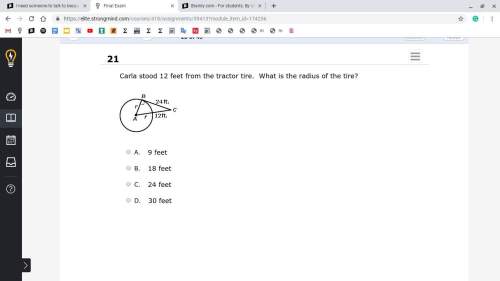
Mathematics, 24.06.2019 11:10 lilymoniquesalaiz
Arailing needs to be build with 470.89 metric ton of iron the factory purchased only 0.38 part of required iron . how much iron is needed to complete the railing?

Answers: 3


Another question on Mathematics

Mathematics, 21.06.2019 15:50
Fredrick designed an experiment in which he spun a spinner 20 times and recorded the results of each spin
Answers: 1

Mathematics, 21.06.2019 19:30
Solve the following simultaneous equation by using an algebraic method (either substitution or elimination) 2x + 3y=-4 4x-y=11
Answers: 1

Mathematics, 21.06.2019 21:30
In δabc shown below, ∠bac is congruent to ∠bca: triangle abc, where angles a and c are congruent given: base ∠bac and ∠acb are congruent. prove: δabc is an isosceles triangle. when completed (fill in the blanks), the following paragraph proves that line segment ab is congruent to line segment bc making δabc an isosceles triangle. (4 points) construct a perpendicular bisector from point b to line segment ac . label the point of intersection between this perpendicular bisector and line segment ac as point d: m∠bda and m∠bdc is 90° by the definition of a perpendicular bisector. ∠bda is congruent to ∠bdc by the definition of congruent angles. line segment ad is congruent to line segment dc by by the definition of a perpendicular bisector. δbad is congruent to δbcd by the line segment ab is congruent to line segment bc because consequently, δabc is isosceles by definition of an isosceles triangle. 1. corresponding parts of congruent triangles are congruent (cpctc) 2. the definition of a perpendicular bisector 1. the definition of a perpendicular bisector 2. the definition of congruent angles 1. the definition of congruent angles 2. the definition of a perpendicular bisector 1. angle-side-angle (asa) postulate 2. corresponding parts of congruent triangles are congruent (cpctc)
Answers: 1

Mathematics, 21.06.2019 21:50
What is the next step in the given proof? choose the most logical approach. a. statement: m 1 + m 2 + 2(m 3) = 180° reason: angle addition b. statement: m 1 + m 3 = m 2 + m 3 reason: transitive property of equality c. statement: m 1 = m 2 reason: subtraction property of equality d. statement: m 1 + m 2 = m 2 + m 3 reason: substitution property of equality e. statement: 2(m 1) = m 2 + m 3 reason: substitution property of equality
Answers: 3
You know the right answer?
Arailing needs to be build with 470.89 metric ton of iron the factory purchased only 0.38 part of re...
Questions

Mathematics, 30.05.2020 22:01






Mathematics, 30.05.2020 22:01

Chemistry, 30.05.2020 22:01




Social Studies, 30.05.2020 22:01








Mathematics, 30.05.2020 22:01




